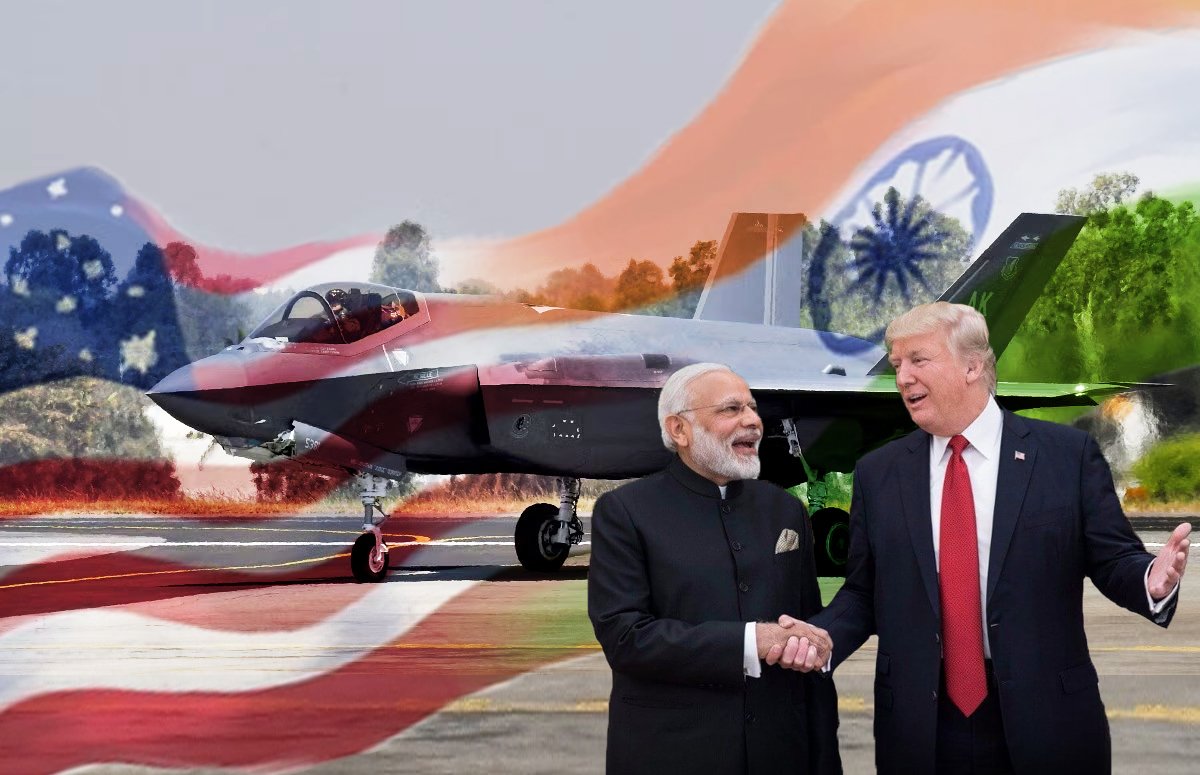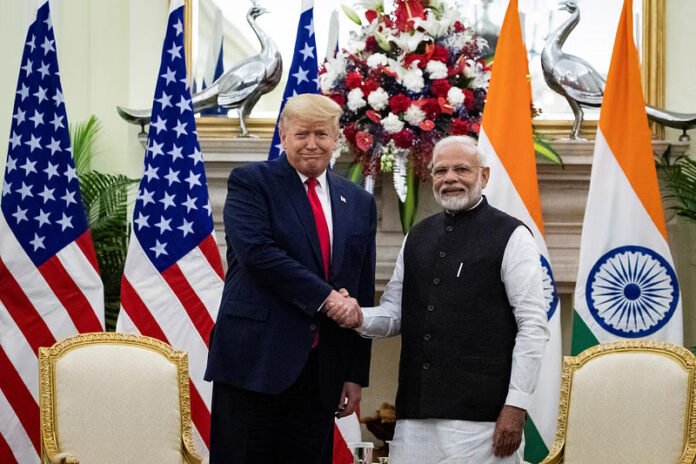President Donald Trump took a diplomatic U-turn by offering to sell F-35 fighter jets to India during Indian Prime Minister Narendra Modi’s recent visit to the United States, which he himself criticised due to its extensive cost overruns as the president-elect in 2016. However, now he seems to be supporting the F-35 program.
“Starting this year, we’ll be increasing military sales to India by many billions of dollars,” Trump told a joint news conference addressed by him and PM Modi. “We’re also paving the way to ultimately provide India with the F-35 stealth fighters,” Trump said.
In an unusual show of humility, Trump complimented PM Modi for being a “much tougher negotiator” and went on to say that he found a “special bond” with PM Modi and India.
This seems to be a significant landmark in Indo-US relations with both Modi and Trump seeming inclined to increase military cooperation across air, land, sea, space, and cyberspace and plan to launch the ‘Autonomous Systems Industry Alliance (ASIA)’ to streamline defence trade and sign a new 10-year defence partnership agreement to replace the one signed in 2015.
The F-35 Lightning II, a single-engine, single-seat, multi-role fighter aircraft developed by Lockheed Martin, has faced significant challenges throughout its development and operational history. These include delays, cost overruns, and technical problems. Notably, the F-35 has been involved in at least 12 crashes since 2018.
The first F-35 crash occurred in 2018 when a US Marine Corps F-35B crashed in South Carolina due to mechanical failure in the aircraft’s engine system. This led to a temporary grounding of the F-35 fleet. The investigation led to several design changes, particularly with the engine and its components.
In April 2019, a 41-year-old Japanese Air Force pilot Major Akinori Hosomi was killed when an F-35A stealth fighter on a night training mission disappeared from the radar screens and crashed into the Pacific Ocean 28 minutes after taking off from Misawa air base. The pilot who had about 60 flying hours of flying experience in the F-35A didn’t even try to eject from the aircraft which reportedly lost control and dropped down at a speed of about 1,100km/h. All communication with the pilot was lost thereafter.
In May 2020, an F-35A belonging to the 58th Fighter Squadron on a training flight crashed while landing at Eglin Air Force Base. Though the pilot ejected safely, the aircraft was destroyed. The crash prompted an investigation by the US Air Force that concluded that the incident was caused by a combination of issues, including malfunction in the aircraft’s flight control system as a result the pilot was unable to control the aircraft during landing.
In November 2021 a British single-engine, short-take-off vertical landing variant of the US F-35 stealth fighter jet on a routine flight operation crashed into the Mediterranean Sea while operating off HMS Queen Elizabeth – one of the UK’s two aircraft carriers and the largest warship (weighing 65,000-ton) the UK has ever sent to sea since HMS Hermes in 1983.
The F-35 Lightning II, a single-engine, single-seat, multi-role fighter aircraft developed by Lockheed Martin, has faced significant challenges throughout its development and operational history. These include delays, cost overruns, and technical problems. The F-35 has been involved in at least 12 crashes since 2018
In January 2022, a South Korean Air Force F-35A made a belly landing after its landing gear malfunctioned due to electronic issues. Finally, on January 28, 2025, an F-35A fighter jet crashed at the Eielson US Air Force Base in Alaska due to an in-flight malfunction during a training session. However, the pilot ejected safely.
This is not all, the F-35 has significant limitations and drawbacks. Lockheed Martin has delivered over 1,000 F-35 aircraft to various countries, including the US military and its allies. The F-35 is one of the most expensive fighter jets in the world, with each unit costing upwards of $80 million. The costs to maintain and operate the aircraft are also steep, averaging $44,000 per flying hour, about double the cost of the Boeing F/A-18E/F Super Hornet. The aircraft’s maintenance requirements are demanding, with extensive repairs needed to keep the fleet operational.
The program has suffered from delays in software upgrades and issues with the aircraft’s performance. The Block 4 software update, which was supposed to enhance capabilities such as new weapon integration, has been delayed repeatedly. Additionally, the aircraft’s complex systems have led to delays and cost overruns, with a 2019 Government Accountability Office (GAO) report revealing that the program had already surpassed $1.7 trillion in costs, making it the most expensive defence program ever.

One of the biggest criticisms of the F-35 is its frequent breakdowns. The aircraft is notorious for requiring longer repair times than expected, and the Pentagon’s target of 60 days for repairs has not been met. In fact, it has taken an average of 141 days to repair a broken F-35. The US government’s reliance on Lockheed Martin contractors for the bulk of maintenance has been a point of contention, as it has resulted in delays and inefficiencies in getting the planes back in service.
Furthermore, the program has faced difficulties in sourcing spare parts, with some 8% of the fleet grounded in early 2022 due to a shortage of critical components. This has led to concerns about the ability to keep the aircraft operational, especially as the Pentagon plans to purchase an additional 780 F-35s by the end of the decade.
The F-35 has also been criticised for its performance in certain areas. While its advanced stealth capabilities are a selling point, the aircraft’s radar and sensors can still be detected under specific conditions, and its range and payload capacity are limited compared to other aircraft in its class. Critics also argue that the aircraft’s overall agility and air-to-air combat capabilities are not on par with other fighters, such as the F-22 Raptor. Moreover, the aircraft’s reliance on a “flying computer” has led to difficulties in integrating its complex systems, leading to frequent bugs and performance issues.
The F-35 has significant limitations and drawbacks. It is one of the most expensive fighter jets in the world, with each unit costing upwards of $80 million. The costs to maintain and operate the aircraft are also steep, averaging $44,000 per flying hour, about double the cost of the Boeing F/A-18E/F Super Hornet
Despite these issues, Lockheed Martin maintains that the F-35 is the most advanced, lethal, and connected fighter aircraft in the world. The company claims that it provides a clear advantage over adversaries and is crucial for maintaining air dominance. However, figures like Elon Musk have been vocal in criticising the program. Musk, CEO of SpaceX and Tesla, referred to the F-35 as “junk,” highlighting its high operational and maintenance costs and arguing that drones offer a more efficient, cost-effective solution to modern military needs.
Musk’s criticism reflects a growing debate about the future of manned fighter jets. With the increasing capabilities of drones, some experts argue that the future of air combat lies in unmanned systems rather than expensive manned fighter jets.
In conclusion, while the F-35 boasts cutting-edge technology and advanced stealth capabilities, its high cost, maintenance challenges, and reliability issues make it a controversial piece of military hardware. With the US now looking to sell this fighter to India, the questions surrounding its long-term value and operational viability remain a key point of discussion. As military budgets continue to be scrutinised, the F-35’s troubled history serves as a reminder of the complexities of modern defence programs.
–The writer is a seasoned media professional with over three decades of experience in print, electronic, and web media. He is presently Editor of Taazakhabar News. The views expressed are of the writer and do not necessarily reflect the views of Raksha Anirveda






